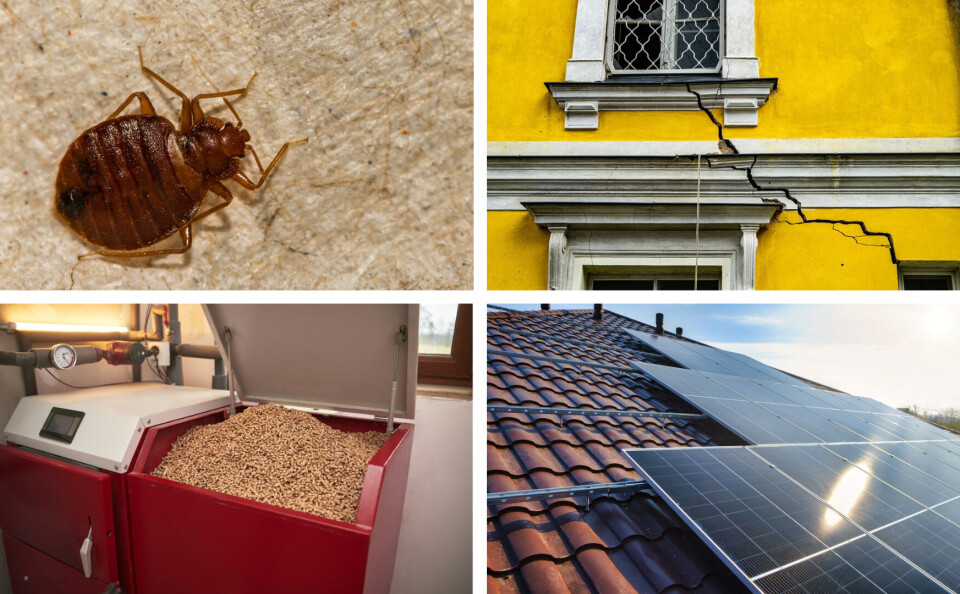-
Poor-quality fibre internet installations remain an issue in France
Stricter measures are announced to improve connection quality
-
Floor collapses in Paris building leaving 20 injured
Water leaking into the building from balcony is thought to be cause of collapse
-
French woman given one-year sentence for hiring men to evict squatter
Homeowner from south-west found guilty by Bordeaux criminal court
French court rules on tradesmen and faulty materials for renovations
Our property ‘round-up’ also looks at new tests to limit drought damage to homes and a big rise in bedbug infestations

1: Wood pellet case shows you can sue tradesmen over faulty materials
Homeowners who wish to claim compensation over faulty renovation work can sue a tradesperson even if their work was up to standard but the materials used were faulty.
A ruling by the Court of Cassation – France’s supreme judicial court – ruled on this point in a case about a faulty heating system this summer.
The homeowners in question were unhappy with a recently-installed wood pellet heater and hot water tank, saying the system did not provide enough hot water nor adequate heating for their home.
An expert appointed by the judge found that there were no faults with the system itself, but that the issue arose from the initial batch of wood pellets that were used being damaged during delivery.
The pellets had been damaged when being moved from the delivery truck to the heater, leaving fine particles clogging up the system and preventing it from working as intended with correctly sized pellets.
The engineer who installed the system was judged to have not been at fault for the installation but responsible for not noticing that the pellets were in poor condition and passing this information onto the homeowners.
The court ruled that he was therefore partially liable and would have to pay 10% of the damages claimed.
However, the Court of Cassation said that this could have risen to 100% if the contract signed between the engineer and homeowners Included an obligation for him to complete all services to a rigid standard (une exécution parfaite de sa prestation).
When contracts including a clause such as this are signed, only proof that an external force majeure prevented the tradesman from completing the project without any issues will exonerate them from paying 100% of the damages claimed.
In the case above, the damaged pellets would not have been counted as an external force majeure, if he had signed a une exécution parfaite de sa prestation contract.
Read more: If you heat French home with wood pellets now may be good time to buy
2: Insurance firms to test new solutions to ‘shrinkage’
Representatives in the building insurance sector have come together to launch an “initiative” testing protections against damage to houses in drought disaster zones.
In particular, they are looking at ways to curtail the damage from ‘shrinkage’, caused by movements in clay soil during times of drought that can cause cracks and ruptures in walls and building foundations.
France Assureurs (a federation of insurance companies), CCR (a public reinsurer) and Mission Risques Naturels (an association designed to help insurers react to the effects of climate change) are all part of the drive.
The group announced that with volunteer policyholders it would attempt to implement preventive solutions and test protective solutions for new buildings. This is in addition to assessing the repair methods recommended by experts.
Four new methods will be tested on around 300 homes. Of these, 200 have already been built – and suffered damage in previous droughts – and will have protections and repairs retroactively applied.
Additionally, 100 homes yet to be built in at risk regions will have preventative techniques applied to them to test their efficacy.
The methods being tested are:
- Rehydrating soil during periods of drought
- Protecting soil year-round (mostly by waterproofing it with a geomembrane)
- Injecting soil near building foundations with products or materials to change its natural state
- Reinforcing building foundations with new designs or materials
A complete assessment will be carried out with annual milestones to identify the most relevant measures over time to strengthen the resilience of individual homes,” the group added in a press release.
The trial is expected to cost around €8.5million over the five years, although this pales in comparison to the expected outlay for insurance claims regarding homes damaged by soil shrinkage.
“More than half of all detached homes in France (11.1 million) could be affected, and 3.3 million of these would be heavily impacted” by shrinkage, the insurers estimate.
The predicted cost of damage to homes by droughts was €3billion in 2022, a record for claims relating to natural disaster (catastrophe naturelle) zones.
On September 9, the Journal Officiel published its updated list of communes classed as ‘drought disaster zones’ relating to 2022’s droughts, which you can read about below.
Read more: 1,000 ‘drought disaster zones’ named in France: what to do if affected
3: Bedbugs on the rise in France
A recent Ipsos study said that 11% of homes in France were infested with bedbugs between 2017 and 2022, with the demand for exterminators of the pests rapidly increasing.
Although thought to be eliminated from France in the 1950s, bedbugs (punaises de lit) have been found in more and more homes since 1990.
The rise in usage of second-hand furniture, increased frequency of travel both domestically and abroad – and the explosion in short-term letting – is thought to have led to their return en masse.
The frustration for many is that their homes can become infected through no fault of their own but via coming into contact with a material containing bed bugs and accidentally bringing them back home without noticing.
The average cost to deal with an infestation in 2023 is around €1,250, according to bedbug insurer ‘Badbugs’.
However, in some homes where the bugs cannot be easily removed, using a ‘heat gun’ to bring the heat of a room up to 70C to kill off the bugs can cost up to €2,000.
More and more AirBnB owners are taking out insurance against the bugs, as cases of infection rise from the high turnover of guests in their properties.
Since 2018, the cost of de-infestation in rented properties has fallen on landlords – the presence of bedbugs means the house is not considered to be in a ‘decent condition’ for renting.
In cases where the landlord can prove there were no bedbugs in the property before the lease was signed, however, and the infestation only began after the tenants moved in, it is the tenant who is liable to pay.
As the bugs can survive up to one year without feeding, this is exceptionally difficult to prove in most cases.
Read more: Insure your French home against bed bug misery for €2 per month
4: France makes push for ‘energy positive’ homes
The number of new homes classed as ‘energy positive’ – meaning they produce more energy than they consume – is on the rise in France, with estate agents and environmentalists alike urging for even more to be built.
New innovations – such as concrete developed at the MIT university in the US which works as a battery, storing excess energy produced by solar panels – should be used in more home constructions, they argue.
Alongside the environmental benefits of homes producing their own green energy, homeowners would see reductions in their energy bills – and perhaps even sell excess energy back to the national grid.
Although the concrete is still being tweaked in the laboratory and yet to be used on a large-scale construction project, other new methods including windows made up partly of photovoltaic solar panels, and 2-in-1 solar panel installations that both provide energy and heat water in your home.
The latter can provide up to four times as much energy as a traditional solar panel installation.
There are even cheaper energy positive methods beginning to hit the market.
A paint manufacturer based in the Côtes d’Armor department has created a thermal paint that traps heat inside when hot and then slowly releases it when cold.
Tempolis’ paint captures a room’s heat when it is above 23C, before letting it out when the temperature drops below this level.
The company estimates it can save homeowners up to 15% on their annual energy bills when applied.
Read more: Eight questions about installing solar panels on homes in France
























